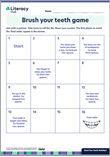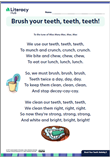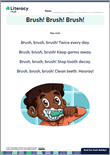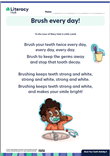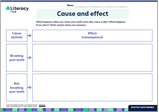Brush Your Teeth!
This catchy, persuasive jingle is written to the well-known tune of 'Twinkle Twinkle Little Star', and it encourages children to brush their teeth regularly.
Back to the shared reading overview page
Text download
Brush Your Teeth! as PDF (673KB) (opens in new window)
Brush Your Teeth! as PowerPoint slideshow (4.5MB) (download)
Printable worksheets
|
|
|
|
|
| Brush your teeth game (122KB) | Brush your teeth, teeth, teeth! (123KB) | Brush! Brush! Brush! (133KB) | |
|
|
|

Teaching & learning sequence
This teaching and learning sequence outlines classroom strategies for Brush Your Teeth! including:
- ways to incorporate the ‘Big Six’ core elements of reading development
- fun, engaging and adaptable student activities for a diverse range of abilities
- links to the Australian Curriculum.
| Text features | Cross-curriculum links to the Australian Curriculum |
|
|

First read
As a whole group, enjoy sharing the text and learning together.
Engage
Initiate a class discussion. Who cleaned their teeth this morning? Why do we clean our teeth? Have students turn and talk about this with a partner. If you were going to persuade someone about the importance of cleaning their teeth, how would you do it? What would you say? Discuss as a class.
Read aloud
Read the jingle aloud to the class, as if it were a poem. Then explain to the class that this text is actually a jingle. Discuss that a jingle is a short, catchy song. Tell the students that this jingle has the same tune as the song ‘Twinkle, twinkle little star’.
Revisit the jingle, this time singing it to the tune of ‘Twinkle, twinkle little star’. Encourage the students to join in. Sing it along with the students a few times until they know it well.
Make meaning
Have students connect with the text. What is your opinion of this jingle? Do you think it would convince people to brush their teeth? Why or why not? Discuss as a class. Encourage students to justify their opinion by giving reasons.
Revisit the text
Return to the text several times to look more closely at different aspects of its content, structure and language features. This is a great vehicle for exploring the ‘Big Six’ of literacy in an integrated way, with all components linking to the same text.
Comprehension
Reading is about making meaning. Choose from these comprehension activities to help your students explore the text deeply, make personal connections, develop new understandings and draw conclusions. The activities will also help students analyse the text, think critically about it and form their own opinions.
Talking text types (whole-group activity)
Draw up a three-column chart with the headings: ‘Purpose’, ‘Audience’ and ‘Message’.
Talk about the purpose of the text and who the audience is. Discuss with the class and use students’ ideas to fill in the first two columns of the chart.
What message do you get from the text? Have students talk with a partner and then share ideas as a group. Encourage students to use evidence from the text to justify their responses. Draw out that the jingle warns people what might happen if they don’t brush their teeth (‘germs’, ‘decay’), it explains the benefits of brushing regularly (‘keeps teeth healthy, strong and white’), and describes how it should be done (‘two times a day’, ‘in the morning and at night’). Scribe students’ ideas onto the third column of the chart.
How else could you persuade somebody to clean their teeth? Use this discussion to talk about other types of persuasive texts such as TV ads, radio ads, posters, speeches, articles in newsletters, letters and billboards.
Australian Curriculum links
Brush your teeth game (partner activity)
What have you learnt about the importance of brushing your teeth? Discuss. Introduce the Brush your teeth game, read through the text written in the squares, and explain the rules.
Have students play the game with a partner. Each pair will need one game card, a die and two counters.
Print the Brush your teeth game.
Australian Curriculum links
Phonological awareness (including phonemic awareness)
These activities will help students to hear the sounds and rhythms of language. Guide them as they explore syllables, onset and rime and listen for phonemes – the smallest units of sound within a word. Use the activities to help your students identify the phonemes in words and practise blending, segmenting and manipulating these sounds.
Rhyming words (whole-group activity)
Revisit the jingle and ask students to listen for rhyming words as you sing Brush Your Teeth! together.
Highlight the long a sound in the words ‘decay’, ‘away’, and ‘day’. Have students turn and talk with a partner about other words with this end sound. Have pairs share their ideas and brainstorm words that end with the long a sound (for example, ‘play’, ‘stay’, ‘hooray’, ‘spray’, ‘may’, ‘prey’ and ‘they’).
Differentiate the activity by challenging students to think of words that have the long a sound in the
middle position such as ‘rain’, ‘tape’, ‘table’, ‘cake’ and ‘steak’.
Repeat with the words ‘night’ and ‘white’, this time highlighting the long i sound.
Australian Curriculum links
Hearing beats in a line (whole-group activity)
Revisit the jingle, and have students clap once for each word as you read (not sing) the first line. As they clap point to each word to reinforce their understanding of 1:1 correspondence between written and spoken words. Continue throughout the remainder of the text.
Now, sing the jingle and have students clap to each beat, which in this case is every second word or syllable (clap as you sing each bold word or syllable: brush your teeth two times a day). Continue throughout the song.
Australian Curriculum links
Segmenting and blending (whole-group activity)
What sounds do you hear in the word ‘teeth’? Have students take turns saying the individual sounds in ‘teeth’ to a partner (t, long e, th). Talk about the three sounds or phonemes, and invite students to orally blend them together to say the word ‘teeth’.
Repeat with the word ‘brush’ this time isolating the four phonemes b, r, u, sh. Ask students to blend the four phonemes together to say the word ‘brush’.
Choose other words from the jingle to isolate, segment and blend phonemes. Differentiate the activity by choosing words with:
- two phonemes such as ‘day’ (d, long a) and ‘two’ (t, oo)
- three phonemes such as ‘white’ (w, long i, t) and ‘night’ (n, long i, t)
- four phonemes such as ‘germs’ (g, er, m, s) and ‘times’ (t, long i, m, s).
Australian Curriculum links
Phonics
Evidence shows that children learn best about the relationship between phonemes and graphemes when instruction occurs through a daily structured synthetic phonics program (also known as systematic synthetic phonics). Knowing about these relationships will help students to decode, and this is crucial for their continued reading development.
In addition to your phonics program it is helpful to expose students to letter-sound relationships they come across in other contexts, such as during shared reading experiences. Choose activities that are relevant to your students so they can practise and reinforce already learnt concepts, so as to build automaticity in recognising letter–sound relationships.
Consonant digraphs (whole-group activity)
Choose words from the text for students to practise and reinforce their understanding of consonant digraphs. For example, write the word ‘brush’ onto a large chart. Underline the letters ‘sh’ and ask students to say the sound these two letters make when they are said together in this word (sh). Have pairs of students talk about other words that have the sh sound in them. Have them share their ideas and discuss as a whole class.
Repeat with the word ‘teeth’, highlighting the consonant digraph ‘th’ making the (voiceless) th sound, the word ‘strong’ with the consonant digraph ‘ng’ making the ng sound and the word ‘white’ with the consonant digraph ‘wh’ making the w sound.
Australian Curriculum links
Decoding words with adjacent consonants (individual activity)
Choose words from the text that students can use to practise and reinforce their blending of adjacent consonant sounds. For example, write the word ‘brush’ on a chart, and have students say the four sounds or phonemes in the word – b, r, u, sh. Explain that the letters ‘b’ and ‘r’ make two distinct sounds, which need to be blended together. Brainstorm a list of other words that have the sounds b and r at the beginning such as ‘broom’, ‘broken’, ‘brick’, ‘brace’, ‘bright’ and ‘brave’.
Have students fold a sheet of paper into four and choose four words beginning with b and r from the class list (or choose their own words). Have them write these four words on their paper and/or illustrate each one.
Repeat the activity using the word ‘strong’, modelling how to blend together the adjacent consonant sounds s, t and r.
Australian Curriculum links
Long vowel sounds (whole-group activity)
Revisit the jingle as an opportunity for students to practise identifying the long i sound. Have pairs of students search for words that have the long i sound in them. Have students share what they discover and write these words on a chart (‘night’, ‘white’, ‘times’). Discuss the two different ways the long i sound is represented in these words (‘i_e’ and ‘-igh’). Ask students to offer other words they know of that have the long i sound in them, and add these to the list. Explore the various letter combinations that represent the long i sound in these words.
Where appropriate repeat with the long a sound (‘decay’, ‘away’, ‘day’) and the long e sound (‘teeth’, ‘keep’).
Australian Curriculum links
R-controlled vowels (whole-group activity)
Revise the 'er' vowel digraph by writing the word ‘germ’ on a chart. Underline the letters ‘er’ and ask the students to say the sound these letters make – er. Reinforce that this is called a digraph because two letters (‘e’ and ‘r’) have combined to make one sound (the er sound).
Talk about other words with the er sound and write these on the chart (for example, ‘fern’, ‘learn’, ‘burn’, ‘stern’, ‘blur’, ‘shirt’, ‘worm’, ‘burger’ and ‘spurt’). Point out the different letter combinations that can make the er sound. (Note: some students might want to include words such as ‘teacher’ and ‘painter’ but in these words the letters ‘er’ make the schwa vowel sound.)
Repeat with the ‘or’ digraph making the or sound in ‘morning’ and ‘your’.
Australian Curriculum links
Oral language
Oral language development begins at birth, and having a rich oral language is beneficial as a foundational and ongoing resource for literacy development. Oral language is embedded throughout the shared reading experience as students listen and respond to quality texts.
It is also valuable to involve students in specific activities that will continue to improve their oral language skills. Choose from these activities that support students to develop and practise important communication skills.
Radio ad (small-group activity)
Have students work in small groups to create an audio ‘radio ad’ that convinces people of the importance of brushing their teeth. The students may choose to include the Brush Your Teeth! jingle in their ad, or they could make up one of their own.
Before the groups begin discuss: What message do you want to pass on to your audience? How will you best convince your audience of this? What will you say? Will you use a jingle? Who will do the speaking? Who will do the singing?
Record each group’s finished radio ad using an audio-recording device. Play the recordings to the whole group.
Australian Curriculum links
Role-play (partner activity)
Have pairs of students plan and present a mock interview with a dentist. Before the pairs begin the task, talk about the types of questions and answers they might include in their interviews. What would a dentist say to convince people to brush their teeth? What questions could you ask a dentist about cleaning your teeth?
Have pairs practise their interviews, and then present them to the class.
Australian Curriculum links
Presentation (partner activity)
Have students work with a partner to plan and prepare a short talk about why it’s important to brush our teeth. What reasons will you give the audience to convince them that they should brush their teeth regularly? Discuss.
Encourage students to think about how they will speak to the group. For example, they could focus on using a loud, clear voice, and looking at the audience when speaking.
If need be support English as an additional language or dialect (EAL/D) students, or other students as required by providing a sentence stem. For example, have them orally finish the sentence: We should brush our teeth because ________.
Australian Curriculum links
Fluency
Activities aimed at teaching and practising fluency are important for students on their journey towards becoming independent readers. Explicitly modelling fluency and providing opportunities for students to practise reading aloud are integral to this.
Exploring rhymes (whole-group activity)
Use Brush Your Teeth! as a starting point to talk about rhymes, chants, jingles or songs that the students know. Encourage students to share rhymes and songs from their own families and cultures. Discuss how the rhymes and/or jingles that the students share are similar to each other and how they are different.
Point out the rhythm and fluency that rhymes, chants, jingles and songs are recited or sung with.
Australian Curriculum links
Readers’ theatre (small-group activity)
Introduce the three jingles based on the topic of brushing teeth: ‘Brush your teeth, teeth, teeth!’, ‘Brush! Brush! Brush!’ and ‘Brush every day!’ Read and sing through each one. Discuss how the jingles are similar and how they are different.
Have small groups choose a jingle they would like to use for a readers’ theatre presentation and print copies for the group members. Have each group practise their jingle and then present it to the class.
Groups could play percussion instruments such as shakers, triangles and castanets to mark the beat of their jingle as they sing.
Print the Brush your teeth, teeth, teeth! jingle.
Print the Brush! Brush! Brush! jingle.
Print the Brush every day! jingle.
Australian Curriculum links
Vocabulary
Having a rich, broad vocabulary assists students when they tackle new texts. These vocabulary activities will help them to build their growing bank of words.
The activities introduce students to new Tier 2 and Tier 3 words, as well as exploring word families and a range of different word types.
Word knowledge (small-group activity)
Write each line of Brush Your Teeth! onto a long strip of paper. Work with a small group of students to reconstruct the jingle using the sentence strips. Encourage students to refer to the jingle on the screen to check for accuracy.
Cut up one of the sentences into individual words, and have the small group work together to reconstruct the sentence.
Discuss the differences between a sentence, a word and a letter.
Invite students to come to the screen and point out high-frequency words that they know such as ‘a’, ‘and’, ‘in’ and ‘the’.
Australian Curriculum links
Morphology (whole-group activity)
Write the word ‘brush’ on a chart. What suffixes, or endings, can we add to ‘brush’? Use students’ ideas to write further words on the chart such as ‘brushing’, ‘brushed’, ‘brusher’ and ‘brushes’.
Talk as a group about how the meaning of the word ‘brush’ changes as each ending is added. Have students take turns saying words from the chart in a sentence to a partner.
Talk about words that can be added to the front of the word ‘brush’ to create a compound word such as ‘hairbrush’, ‘toothbrush’, ‘paintbrush’ and ‘bottlebrush’. Talk about the meaning of each word.
Australian Curriculum links
Teeth topic words (whole-group activity)
Write the word ‘teeth’ in the middle of a large chart. What words can you use when talking about the topic of ‘teeth’? Have students talk with a partner about this. Pairs can then join with another pair to share their ideas and discuss further.
Bring the students back together as a whole group and ask them to share the words they thought of in their smaller discussion groups (for example, ‘brush’, ‘floss’, ‘germ’, ‘decay’, ‘dentist’, ‘fillings’, ‘tooth’, ‘molar’, ‘bite’, ‘chew’, ‘canine’, ‘baby teeth’, ‘adult teeth’).
Use students’ responses to create a semantic web on the large chart, related to the word ‘teeth’.
Encourage EAL/D and CALD students to share words related to the topic such as ‘teeth’, ‘brush’ and ‘toothbrush’ in their home language.
Australian Curriculum links
Brush – verb or noun? (whole-group activity)
Show the class a hairbrush (or draw one on a chart). What is this? Explain that it is a brush, and a brush is a thing, so the word ‘brush’ is a noun.
Use the hairbrush (or pretend) to brush your hair. What am I doing? Explain that you are brushing your hair. The word ‘brushing’ is describing an action, so the word ‘brushing’ is a verb. Pose the question: What if I say, ‘Can you brush my hair?’ What sort of word is ‘brush’ in this sentence? Discuss and draw out that the word ‘brush’ in this sentence is an action word, or a verb.
So, is the word ‘brush’ a noun or a verb? Discuss and draw out that the word ‘brush’ can be both a noun and a verb, depending how it is used. Model saying the word ‘brush’ in a sentence as a noun, and then as a verb. Have students say two sentences to a partner that show ‘brush’ as a noun and then as a verb.
Present and discuss other words that can be both a noun or a verb; a thing or an action (for example, ‘hike’, ‘slide’, ‘wave’, ‘bowl’ and ‘park’).
Australian Curriculum links
Number homophones (whole-group activity)
Revisit the jingle and point to the word ‘two’ in the first line. What does this word say? What does it mean? Write the words ‘two’ and ‘to’ on a chart. How are these words the same? How are they different? Discuss and draw out that they sound the same but they are spelt differently, and have different meanings. Explain that words like this are called homophones.
Investigate other number homophones (‘one – won,’ ‘four – for’ and ‘eight – ate’). Have students say each of the homophones in a sentence to demonstrate their different meanings.
Australian Curriculum links
- Year 2: AC9E2LA07
Reflecting on learning
Help students ‘bring it all together’ and reflect on their understandings by completing the graphic organiser either independently or with a partner.
Cause and effect chart
What is the jingle trying to persuade people to do? Discuss.
Discuss the effects of cleaning your teeth every day, twice a day. What are the benefits of doing this? What could the consequences be if you don’t? Have students fill in the cause and effect chart.
Print the Cause and effect chart.
For families - new for 2024!Reinforce your classroom learning by telling families in your class about Brush Your Teeth! Families can share the text at home and use the information provided to build knowledge and instill a love of reading. |
